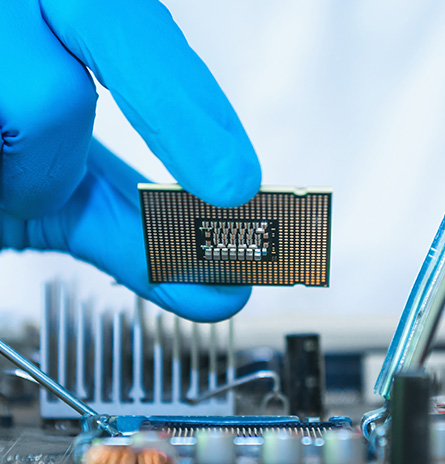NerO – An Energy Efficient Arduino UNO Compatible Design
Project Background
This project was started out as an accessory for another planned KickStarter project – a smart TFT display for Arduino called Cleo. Now, the display itself required 150mA current, fine, but when you add a camera with its LED lights, this goes up to 250mA and if you have 1W audio playing simultaneously, unlikely, but possible, then it would require 450mA of current at 5V in order to guarantee operation. You could the USB jack to supply 500mA power, but this doesn’t leave much headroom to power other Arduino shields, so connecting a PSU to the DC jack seemed to be the answer.
This started us thinking – well, the LDO regulator on an UNO and compatible boards is rated at 1A but how much current can you actually take without the regulator overheating and shutting down. We decided to measure it on a genuine UNO R3 board at 9V and 12V input, and the answer was surprisingly low especially with a 12V supply. Our measurements and test methodology are shared with you below.
The UNO R3 is the staple of most Arduino based projects but it’s been around for a number of years and many of the features have been improved for example by Adafruit and Sparkfun who make excellent enhanced UNO compatibles. However, our additional requirements for a full 1A current without excess heat dissipation and FCC/CE conformity led us to consider a new 3rd party UNO compatible reference design that met these requirements hence the inspiration behind NerO. We were delighted with the results of our prototype so we decided to make it available in its own right for anyone to use. On launch we will make the NerO schematic and pcb design files available publicly as a reference design under OSHWA (Open Source Hardware Association ) terms and welcome the community to benefit from our original design work.
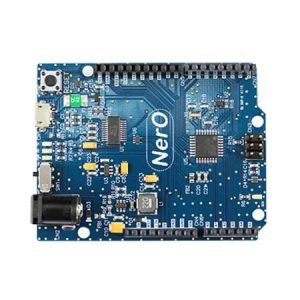
Specifications & Enhancements
General Specifications
Key Features
- Hi-Speed USB to one-wire interface converter
- Micro USB connector
- Status and PWR LEDs moved to edge of PCB – and remain visible when a shield is placed on the expansion connectors
- On-Off Switch for added user convenience
- FTDI FT231X USB UART (Note 1)
- 5V Switching regulator vs LDO regulator (Note 2)
- FCC/CE certified (Note 3)
- Quality product – manufactured in Europe (Note 4)
Note 1 – FT231X is one of the latest X-series family of USB UART solutions from FTDI. It has larger communication buffers at a lower cost compared to our popular ubiquitous FT232R device. FT231X has 3.3V output levels and 5V tolerant inputs. FTDI provide drivers for its USB bridge devices across many platforms including certified drivers for Windows, including Windows 10.
Note 2 – The NerO Buck Switcher regulator is much more energy efficient than an LDO device especially at higher Voltage inputs. It can supply a full 1A current at 5V without breaking sweat, or anything else. Great in all circumstances where external power is used – especially for designs with higher power requirements such as driving displays/LEDs/ Wi-Fi etc. An excellent solution for for 9V battery powered solutions, automotive ( 12V ) and POE designs as well.
Note 3 – NerO is FCC/CE certified as is the original UNO, and so is suitable for commercial applications as well as hobbyist/maker projects. Most other compatibles are not FCC / CE certified. NerO is manufactured using quality manufacturers and components and, despite this, is still priced at an affordable level (under $20 US) for all. Our Kickstarter backers can enjoy a 25% or more discount on the R.R.P.
Note 4 – As mentioned above, manufacturing quality is very important to us – so we have partnered with MikroElektronika in Europe to manufacture our NerO using their advanced SMT assembly line. We plan to show you around their production line in a coming Project Update.
NerO Documentation
- NerO Datasheet
- NerO Open Source Hardware Project Files – Please note, FTDI Chip utilises Altium Designer as our hardware design tool. Please install this tool 这里 before viewing or editing the files.
- NerO Schematic – in PDF format
- NerO PCB Prints – in PDF format
- NerO Assembly Prints – in PDF format
- NerO Bill of Materials list – in Excel format
Prototype Testing
Here’s a few of the tests we carried out on our prototype NerO board.
Load Current Measurement
First we constructed a “load board shield” consisting of 20 x 100 ohm resistors and jumpers on each between 5V and GND. By inserting/removing jumpers we can simulate shield load currents on the 5V rail from 0mA to 1A in 50mA increments.
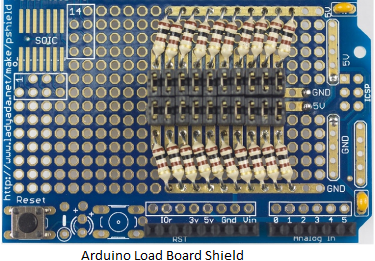
Should you like to make your own and repeat the experiment, we used an AdaFruit ProtoShield v6, shown above, to make this.
Next, we measured the performance of the regulator as we increased the load current using the above board, firstly using a 9V DC supply on the DC Vin Jack, followed by the same test but with a 12V supply.
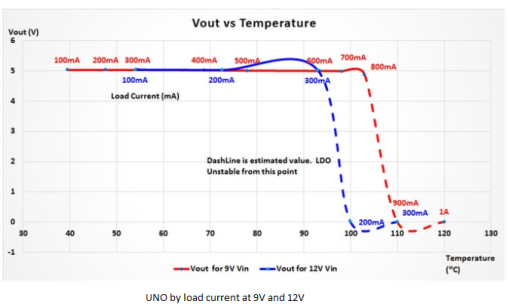
Firstly – here’s the results on a genuine (made in Italy) Arduino UNO R3. With a 9V DC suppy, the regulator starts to go into thermal shutdown at just over 700mA current draw, likewise at 12V DC it starts to go into thermal shutdown at just over 250mA current draw. However, please note that at this stage the LDO regulator external temperature is around 95C to 110C – extremely hot and capable of reducing the lifespan of nearby components on the board. If, for instance, we decided that a realistic maximum temperature of the regulator should be 70C, to be on the safe side, then the maximum shield 5V current draw would be around 400mA with a 9V DC supply and under 200mA with a 12V DC supply. Food for thought!
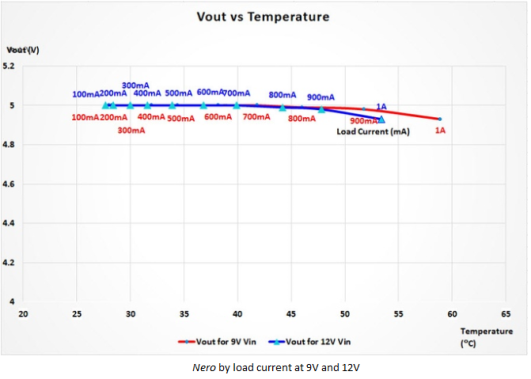
Now, we repeat the above experiment, this time with a NerO board. At both 9V and 12V DC input, the regulator remains stable all the way up to a full 1A load, thus meeting our design target. The regulator temperature stays well below 60C in all conditions.
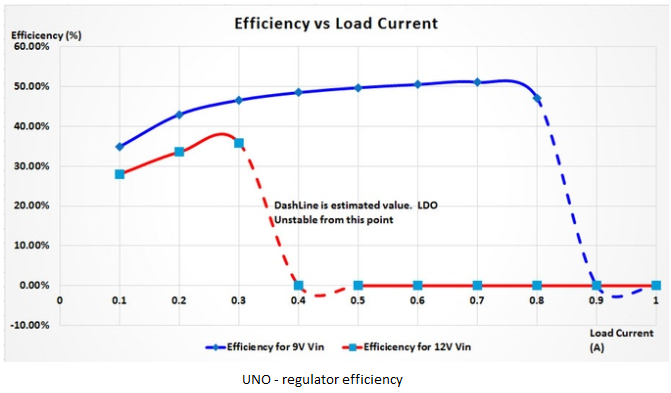
Now, lets take a look at regulator efficiency vs. load current. As expected the UNO tends to be within the 30 to 50% range depending on the load current.
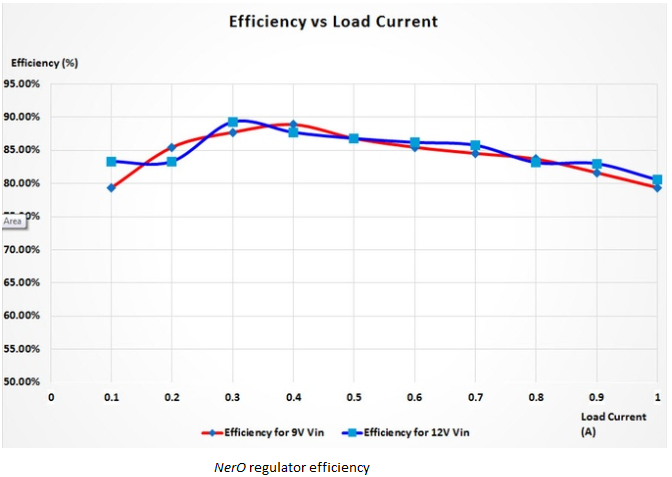
NerO sits in the 80 to 90% efficiency range, again depending on the load current.
5V Supply Ripple
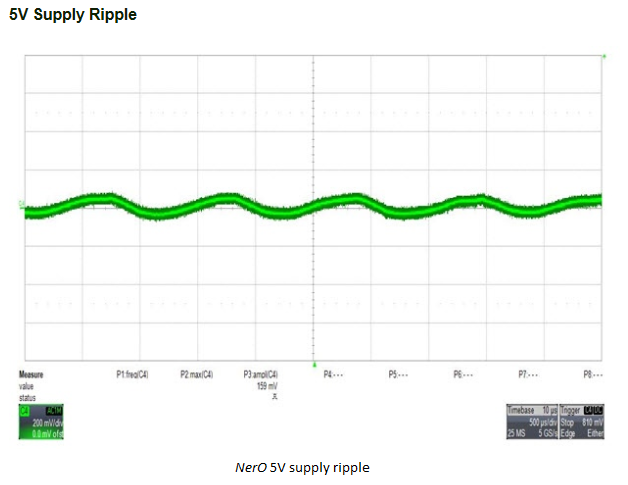
A measurement of the supply ripple on the output of the NerO switching regulator using an oscilloscope reveals it to be under 200mV peak to peak – perfectly adequate for driving digital logic.
USB Signal Quality
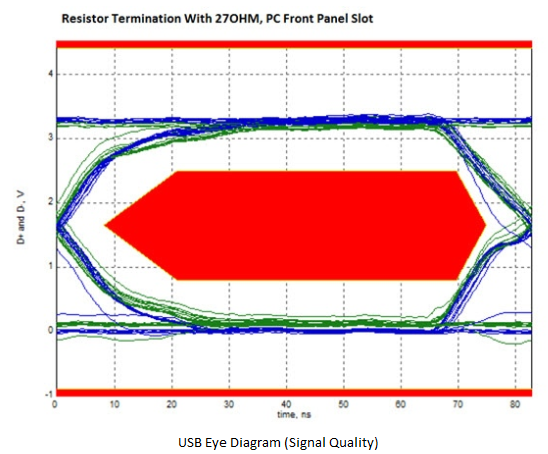
If you’ve not seen one before, the above diagram is known as an Eye Diagram and is used to measure signal quality down a transmission line. It’s done using a special ( and often expensive ) oscilloscope. This ensures reliable communication across all qualified platforms. Having one to hand, we put NerO to the test, and are pleased to say it passes well. NB – a failure is where the signal dips into the red polygon in the center of the ‘eye’.
There is an FTDI FT231X chip on the Ner0 module and the FT231X datasheet is available 这里.
Please install the VCP and D2XX driver by the setup executable and it is available 这里.


